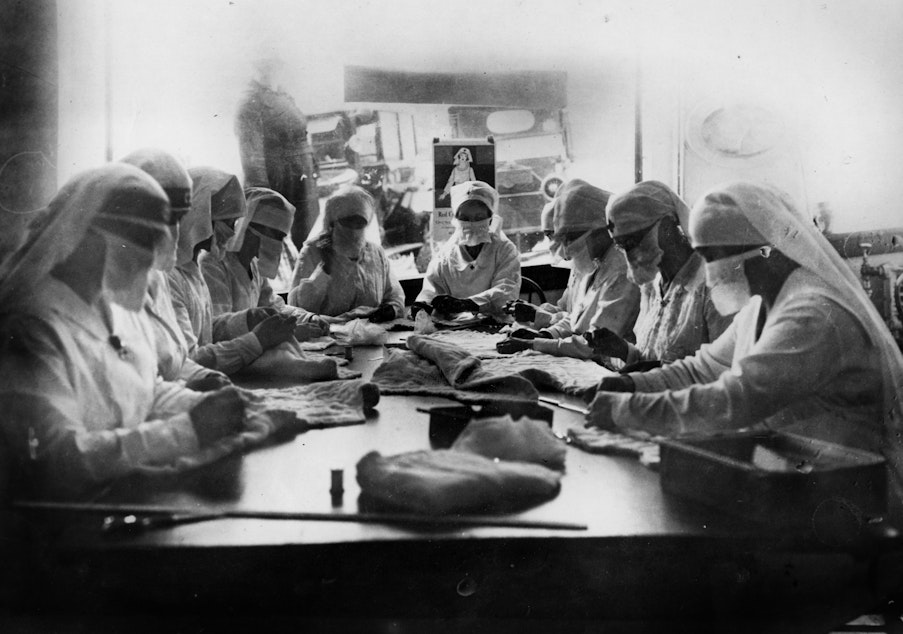Lessons from the last time Seattle let its pandemic guard down, in 1918

During the 1918 flu pandemic, Seattle put in place some tight restrictions on masking and gathering. The decisions that followed were catastrophic and a lesson for letting your guard down around the holidays amid a pandemic.
This interview has been edited for clarity.
Kim: What happened when the flu first struck the region in 1918?
Berger: Seattle got hit with it in the fall of 1918. It found its way into Army and Navy camps. It was spread largely by soldiers and sailors. It first cropped up in September of 1918, at Camp Lewis, and at the Bremerton shipyard.
What kind of impact did it have when it first got here?
At first there was denial, but by early October they realized the pandemic was here. And, people were so busy with the war effort, it was almost like a secondary concern, but as people started dying, especially young naval cadets, they began to take it more seriously.
Sponsored
I remember reading the impact on young people in particular was really severe, and very sudden. People could die within hours, or days. When they realized how serious this was, what kinds of things did officials do? What did they what measures did they put in place?
They started both at the state and the city level. The head of the health department in Seattle decided that they needed to practice social distancing, they needed to close down public gatherings. People needed to wear masks if they were going to be in public or going to the store. They suspended schools, they closed churches, anything where people would gather, saloons, billiard rooms, theaters, the works, and nothing like that had happened before.
That sounds familiar to us today, of course. I'm wondering, folks back then, how did they respond to all of that?
It was a mixed response. Partly, people complied pretty well here in Seattle, certainly compared to some other cities. It was pitched as part of the war effort. You have to remember, in 1918 we were still at war. Seattle was all geared up for the war. We were building ships and sending material over, and troops. It was seen as kind of a patriotic thing, because they didn't want the disease to interfere with the war effort.
Then good news was declared on November 11, the war was over. What did that trigger?
Well, it triggered celebrations, which were very understandable. People had been doing without, for a year previous to the flu arriving, because of the war effort. Parties had been canceled. Everybody was devoted to volunteer work or defense work. And people just celebrated: parades, impromptu bonfires, and immediately following that the restrictions, which had been in place for about five weeks, were taken off.
Do we know why they decided to roll those restrictions back at that time?
I think they were getting a lot of pushback from the restrictions. People weren't happy about it. The ministers were weren't happy about the church rules. The school superintendent wasn't happy about the school closures. I think the kind of euphoria at the end of the war, people felt like they'd sacrificed enough and it was it was time to get back to normal.
People went back to their ordinary lives, and what happened?
The ordinary life in November of 1918 meant Thanksgiving, it meant Christmas, it meant New Years, it meant balls, parties, dances, family gatherings. At first, it was demonstrable that the social distancing and masking had worked. The rate of infection had dropped. The death rate had dropped. There was tangible evidence. I think there was just a premature sense that the epidemic was over. In fact, The Seattle Times had a headline “Epidemic Virtually Over,” it said on November 12.
Sponsored
People were just eager to get back to life as it had been before. By January, you began to see all the numbers ticking up again, disease numbers, death numbers. When I looked at the death records, there were as many people died after January as died before January when the tallies were done in the end. It was really midway through the pandemic that they threw off the restrictions.
We are now heading into our holidays this year. Thanksgiving is next week already. I'm wondering what lessons you are taking away from 1918 right now?
The epidemic lasted from 1918 really into 1920. People have tended to forget it lasted longer than the sort of official period. That's one of the things I take away from it, is that just because you want something to be over doesn't mean it's over. Social distancing and masking worked. It's one reason we do it now. And when you stop doing it, because you think you're successful, that might be premature.
We're repeating many of the same mistakes, and of course we're faced with many of the same challenges. The reason it's a pandemic is the disease is new, and we're still trying to figure it out. I kind of jokingly said, pandemics should happen more frequently, because 100 years between, you forget everything you learned the first time.
What are you doing for Thanksgiving this year?
I'll probably be Zooming with family. We've talked about making food for each other and leaving it on doorsteps. We won't be getting together in any kind of way. We've got lots of vulnerable family members, and also people who are in health care, and at high risk. We're going to be very careful, as we have been, and follow the science and the what Governor Inslee would like us to do and not do.
Listen to the interview by clicking the play button above.





